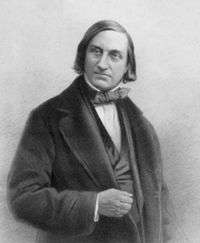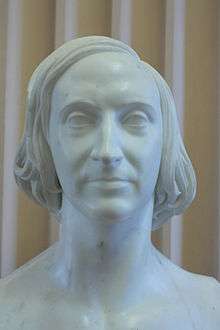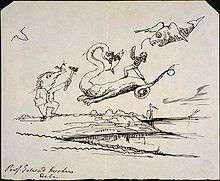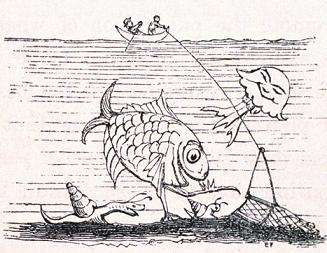Edward Forbes
Professor Edward Forbes FRS, FGS (12 February 1815 – 18 November 1854)[1] was a Manx naturalist.
Edward Forbes | |
|---|---|
 Edward Forbes | |
| Born | 12 February 1815 |
| Died | 18 November 1854 (aged 39) Wardie, Edinburgh |
| Nationality | Manx |
| Alma mater | University of Edinburgh |
| Known for | Azoic hypothesis |
| Scientific career | |
| Fields | Natural history |
| Institutions | Geological Society of London King's College London Geological Survey of Great Britain Royal School of Mines University of Edinburgh |
| Influences | Robert Jameson |
| Author abbrev. (botany) | E.Forbes |


Early years
Forbes was born at Douglas on the Isle of Man. As a child, Forbes was very interested in collecting insects, shells, minerals, fossils, and plants. Due to poor health, he was unable to attend school from his 5th through his 11th years. In 1828, he started attending the Athole House Academy in Douglas.
In June 1831, Forbes moved to London to study drawing. However, having given up on art as a profession, he moved back to Douglas. In later years, Forbes used his artistic abilities to create humorous drawings for his publications.
In November 1832, Forbes matriculated as a medical student in the University of Edinburgh. In 1832, he studied the natural history of the Isle of Man.[2] Forbes' brother David was a notable mineralogist.
Travels
In 1833, Forbes travelled to Norway to study its botanical resources. His findings were published in Loudon's Magazine of Natural History for 1835–1836. In the summer of 1834, Forbes spent time to dredging in the Irish Sea for biological specimens. In 1835, he travelled in France, Switzerland and Germany to study their natural histories.[2]
In 1836, Forbes abandoned his medical studies and moved to Paris, where he attended the lectures at the Jardin des Plantes on natural history, comparative anatomy, geology and mineralogy.[2] In April 1837, Forbes traveled to Algiers to gather material for a paper on land and freshwater Mollusca. The paper was published in the Annals of Natural History, vol. ii. p. 250. That fall, he registered at Edinburgh as a student of literature.
In 1838, Forbes published his first volume, Malacologia Monensis, a synopsis of the mollusk species native to the Isle of Man. During the summer of 1838 he visited the Duchy of Styria (now part of Austria and Slovenia) and Carniola in Slovenia to gather botanical speciments.[2]
Scholarly years

Marine biology
In 1838, Forbes presented a paper to the British Association at Newcastle on the distribution of terrestrial Pulmonata in Europe. He was then commissioned to prepare a survey on pulmonata in the British Isles. In 1841, Forbes published his History of British star-fishes, embodying extensive observations and containing 120 illustrations, all designed by Forbes.
On 17 April 1841, Forbes and naturalist William Thompson, joined at Malta HM surveying ship Beacon, to which he had been appointed naturalist by her commander Captain Thomas Graves (1802–1856). From April 1841 until October 1842, Forbes investigated the botany, zoology and geology of the Mediterranean region.[2]
In 1843, Forbes presented a Report on the Mollusca and Radiata of the Aegean Sea,[3] to the British Association. In the report, he discussed the influence of climate and of the nature and depth of the sea bottom upon marine life. He divided the Aegean region into eight biological zones. In his azoic hypothesis, Forbes stated that the sea regions below 300 fathom were entirely devoid of life. This hypothesis was disproved 25 years later. [4][2]
In 1847, Forbes published Travels in Lycia with Lieut. T.A.B. Spratt. In 1848, he published his monograph on jellyfish, the British Naked-eyed Medusae (Ray Society).
In 1852, Forbes published the fourth and concluding volume of Forbes and S. Hanley's History of British Mollusca He also published his Monograph of the Echinodermata of the British Tertiaries (Palaeontographical Soc.).[5]
Posts in London
In 1842, financial pressures forced Forbes to take the curatorship of the museum of the Geological Society of London. In 1843, he also became a professor botany at King's College London.
In November 1844, Forbes resigned the curatorship and became palaeontologist to the Geological Survey of Great Britain.[2]
On August 26 1848, Forbes married Emily Marianne Ashworth, the daughter of General Sir Charles Ashworth.
Botanical studies
In 1846, Forbes published in the Memoirs of the Geological Survey his important essay On the Connection between the distribution of the existing Fauna and Flora of the British Isles, and the Geological Changes which have affected their Area, especially during the epoch of the Northern Drift.
In this essay, Forbes divided the plants of Great Britain into five geographic groups and compared them to other regions in Europe:
- The West and Southwest Irish group, related to flora from Northern Spain
- The Southeast Irish and Southwest English group, related to flora of the Channel Islands and nearby coastal France
- The Southeast English group, characterized by species from the Northern French coast
- The mountain summits group, related to Scandinavian flora
- A general or Germanic flora group
Forbes theorized that the majority of British terrestrial animals and flowering plants migrated there over land bridges before, during and after the ice age.[6]. His theory was later discredited. (see C Reid's Origin of the British Flora, 1899).
In 1851 Forbes was professor of natural history to the Royal School of Mines.
T. H. Huxley
Forbes served as an important mentor to the young biologist Thomas Henry Huxley. During Huxley's 1846 to 1850 voyage on HMS Rattlesnake to Northern Australia, Huxley relayed news of his discoveries back to Forbes in the United Kingdom, who then published them.
Forbes provided Huxley with introductions to influential people, wrote a favorable review of Huxley's work, and helped his admission to the Royal Society (FRS) at age 26.[7]
Final years
In 1853 Forbes became president of the Geological Society of London. In 1854, he was appointed professor of natural history at the University of Edinburgh, a long sought goal. During his later years, Forbes found more time in between lecturing and writing to order his stores of biological information.
In the summer of 1854, Forbes lectured at Edinburgh and in September served as president of the geological section at the Liverpool meeting of the British Science Association.
In November 1854, soon after the start of winter classes at Edinburgh, Forbes became ill. He died at Wardie Parish, near Edinburgh, on 18 November 1854.[5] He was interred at the Dean Cemetery in Edinburgh.
In 1859, a former student of Forbes; James Hector dedicated Mount Forbes in what is now Banff National Park in Alberta, Canada to his memory.[8]
The following Forbes works were issued posthumously:
- On the Tertiary Fluviomarine Formation of the Isle of Wight (Geol. Survey), edited by RAC Godwin-Austen (1856)
- The Natural History of the European Seas, edited and continued by RAC Godwin-Austen (1859).[5]
Notes
- Egerton, III, Frank N. (1970–1980). "Forbes, Edward, Jr.". Dictionary of Scientific Biography. 5. New York: Charles Scribner's Sons. pp. 66–68. ISBN 978-0-684-10114-9.
- Chisholm 1911, p. 637.
- Forbes 1844.
- Anderson & Rice 2006, p. 131–137.
- Chisholm 1911, p. 638.
- Chisholm 1911, pp. 637,638.
- White, Paul (2003). Thomas Huxley: Making the 'Man of Science'. Cambridge University Press. pp. 37. ISBN 9780521649674.
- "Mount Forbes : Climbing, Hiking & Mountaineering : SummitPost". Summit Post. Retrieved 19 June 2019.
- IPNI. E.Forbes.
References
- Anderson, T.R.; Rice, T. (December 2006). "Deserts on the sea floor: Edward Forbes and his azoic hypothesis for a lifeless deep ocean". Endeavour. 30 (4): 131–137. doi:10.1016/j.endeavour.2006.10.003. PMID 17097733.CS1 maint: ref=harv (link)
- Forbes, E. (1844). "Report on the Mollusca and Radiata of the Aegean Sea, and on their distribution, considered as bearing on geology". Report of the British Association for the Advancement of Science for 1843. pp. 129–193 .CS1 maint: ref=harv (link)
- Attribution

- Literary Gazette (25 November 1854);
- Edinburgh New Philosophical Journal (New Ser.), (1855);
- Quart. Journ. Geol. Soc. (May 1855);
- G. Wilson and A. Geikie, Memoir of Edward Forbes (1861), in which, pp. 575–583, is given a list of Forbes's writings.
- Literary Papers, edited by Lovell Reeve (1855).
External links
| Wikimedia Commons has media related to Edward Forbes. |
| Wikisource has original works written by or about: Edward Forbes |
- Memoir of Edward Forbes, by George Wilson and Archibald Geikie (MacMillan and Edmonston co., 1861); Google Book Search
- Edward Forbes obituary, by Thomas Huxley (Journal of Science and Literary Gazette, 1854); Clarke College
- Manx Worthies: Professor Edward Forbes (and part 2), by A.W. Moore (The Manx Note Book, Vol. iii, 1887)
- Chrono-biographical sketch; Western Kentucky University